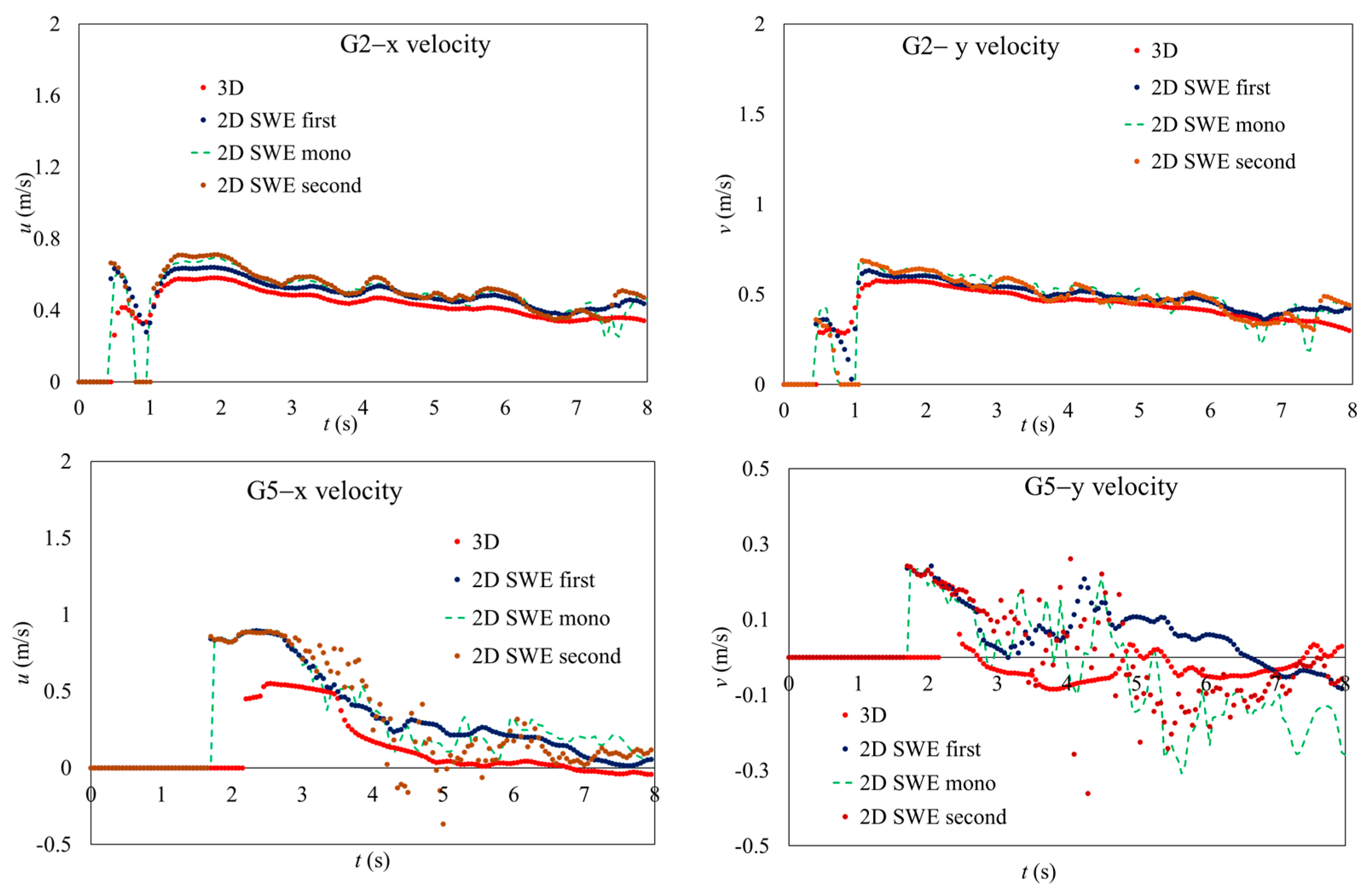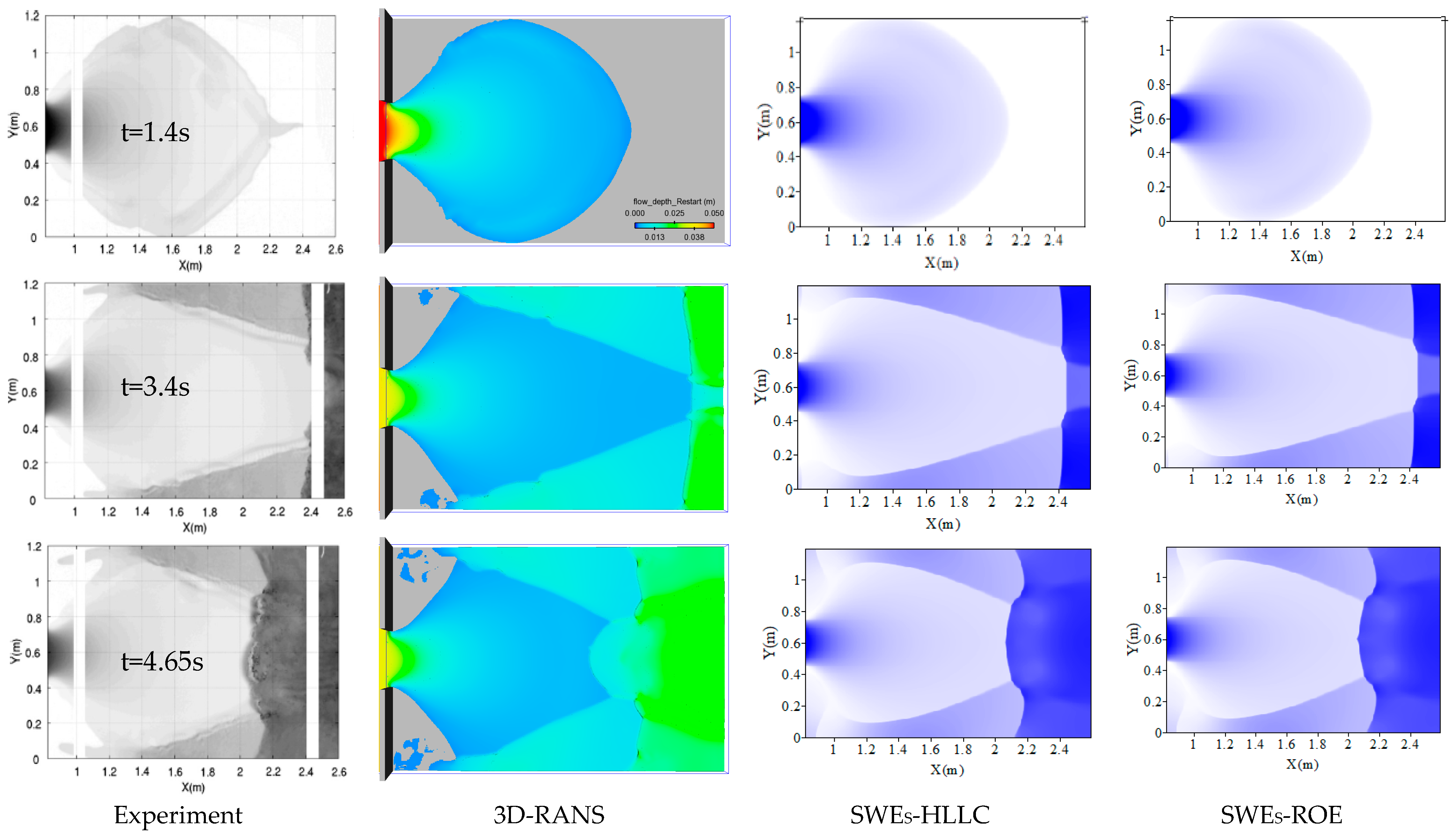3.1. Dam Break Wave in Dry and Enclosed Domain without Building
The first step of our investigation is to determine the possibility of three numerical schemes 1, 2, and 3 in the shallow water module of Flow 3D. The strong turbulence is observed in all numerical inundated maps (
Figure 2). Compared with measured data, all numerical schemes predict the propagation of shock waves at an early stage (
t = 1.4 s) with the same shape and area of the wetted area. At later times, three reflected waves produced undulating and overlapping in a complex way. The interaction between the forward and backward wavefront led to an oblique hydraulic jump. Despite this, the wavefront reflected against the channel sidewalls occupies a much larger area than the observed wavefront. Further,
Figure 3 shows three reflected zones, S
I, S
II, and S
III, caused by three vertical boundaries. The percentage errors of reflected area (
E%) presented in
Table 3 indicated that a small value of
E at
t = 1.4 s (0.05% for model 1, 1.21% for model 2, and 0.28% for model 3) shows the close matching between numerical and experimental results. However, the dispersion and diffusion are witnessed at
t = 3.4 s and 4.65 s. For example, the relative error (
E%) at zone 3 is 95.43%, 58.55%, and 47.49% in accordance with models 1, 2, and 3, respectively (
Table 3).
On the other hand,
Figure 4 shows water level profiles at five gauges obtained by these models. The first-order accuracy scheme produces numerical results more stable than those obtained by models 2 and 3. Further, the
NRMSE value shows that results at G1 and G2 near the dam site obtained by this model are better than solutions obtained by both second-order schemes. Results at G3, G4, and G5 near the downstream boundary witness the approximate value of
NRMSE indexes. The numerical solutions generated by models 1, 2, and 3 at G2 show a large surge at the end, while others do not (
Table 4). Although the RANs model has a high relative error of 9.32% at the early stages of dam failure, this value diminishes quickly at t = 3.4 s and 4.65 s when the relative error gets 0.94% and 0.6%, which are small in comparison to other models.
Besides flow depth hydrographs, velocity components in the
x and
y directions are also important hydraulic features in studying free surface flow. However, there is no empirical data on velocity components in Aureli’s work; a 3D numerical solution is considered as reference data to evaluate 2D results in
Figure 5 because 3D numerical results of
u and
v showed very good agreement with experiment ones [
25]. In general, the time series of
u and
v obtained by the 3D model are quite stable. All numerical data at gauge G2 closed with the dam gate are matching together. However, the numerical simulations at gauge G5 is strongly dispersion. The maximum values of
u and
v at gauge G5 obtained by models 1, 2, and 3 are quite larger than that obtained by model 4. Thus, it is necessary to have measured data of velocity to validate every numerical scheme.
Furthermore,
Figure 6 and
Figure 7 present inundated maps and water depth profiles that use the 3D RANs model and 2D models of ROE and HLLC. Obviously, the strong undulation almost disappears in all flood maps (
Figure 6). The wavefronts reflected by the three side walls are quite similar to those observed empirically (at
t = 3.4 s and 4.65 s). At
t = 4.65 s, 3D results perform better than 2D ones because the backward wave does not reach the dam site, while 2D solutions barely touch the dam. Further, G1 and G2 indicate the trend of the flow depth profile obtained by turbulence module RANs is quite close to the observed one, while 2D solutions are underestimated (
Figure 7). The arrival time of the forward wave interacting with the backward one formed by models 4, 5, and 6 can be captured well at all gauge points, while three modules of Flow 3D’s shallow cannot be predicted correctly (
Figure 4 and
Figure 7). The value of the statistical error indicator also proved that the
NRMSE of 3D results is small except for point G4 (
Table 4). This means the 3D numerical scheme is the best performance in case of rapid flow on dry and closed domains without obstacles.
In general, the flood extent of Flow 3D is reasonably represented by three options of the shallow 2D model. For inundated maps and flow depth profiles, first-order accuracy provides the best solution. The RANs model is the most accurate among the six selected numerical schemes. Two 2D numerical schemes by Roe and HLLC perform quite similarly in all hydraulic aspects. In the early stages of dam collapse, the overestimation of shock performance is still witnessed on flooding maps.
3.2. Dam Break Wave in Dry and Enclose Domain with Presence of Building
In addition, the presence of a building can make the flow regime more complicated due to the interaction of the dam break wave with the building.
Figure 8 and
Figure 9 demonstrate how intense undulation produces hydraulic jumps in a complex manner. However, the numerical instability is observed in numerical results obtained by three numerical schemes of the shallow module, while the formation of dam break wave generated by models 4, 5, and 6 are quite matching with the measured ones (
Figure 8 and
Figure 9). Numerical schemes 5 and 6 generate flood map formation quite similarly. At
t = 4.0 s, the reflected wave on the left side performed by models 5 and 6 touches the dam site, while the solution of 3D does not (
Figure 9). This means that the 3D solution is better than others. Further, it is found that three models, 1, 2, and 3, cause much more expansion of three reflected zones than the observations (
Table 4). At
t = 4.0 s, the percentage error of refected (S
III) are 39.59%, 69.20%, and 48.05% for three models 1, 2, and 3, respectively. However, the results obtained by models 4, 5, and 6 show more acceptable errors, although this value is greater than that in the case of the absence of the building (see
Table 5). Further, the stage hydrographs presented in
Figure 10 and
Figure 11 show the oscillation occurring at almost all gauges (except G1). This hydraulic aspect yielded by models 1, 2, and 3 shows a downward trend at the last time, whereas the time series of observed data increase quickly and peak at this moment. This conclusion is also revealed by
Table 6 when the
NRMSE obtained by models 1, 2, and 3 at gauges G2, G3, and G4 are much greater than those yielded by models 4, 5, and 6.
Therefore, the presence of buildings within a dry and enclosed domain creates a complicated shockwave effect. Particularly, the significant disagreement of numerical flood extents is observed in three models: 1, 2, and 3. The intense fluctuation is formed in both flooding maps and stage hydrographs.
NRMSE is so large at gauges G2, G3, and G4, with almost
NRMSE values are greater than 0.3, that the accurate level cannot be accepted to some extent. This limitation may come from Flow 3D solving the non-conservative form of 2D−SWE. In contrast, two proposed numerical models used FVM to solve the conservation form of 2D SWEs give much better solutions when the undulation is reduced in all inundated maps. Water stage profiles and statistical error indicators (NRMSE) show reasonable trends and values, respectively, but their accuracy is less than 3D solution. This point shows that the coupling turbulence module in RAN equations can accurately simulate the non−hydrostatic, transmissive flow. Especially, at an early stage of dam collapse, or the presence of obstruction, it makes a significant impact on 3D hydraulic characteristics. This comment can be proved by the restimulation of the test case in the Kocaman study [
15], which is presented in
Section 3.3.
3.3. The Influence of Initial Wave Celerity on Dam Break Wave on Dry and Enclosed Domain
In a test case of dam break flow over dry and closed domain taken from [
15], the initial water level (
h0) was 0.15 m, corresponding with wave celerity
= 1.213 m/s, which was greater than that in the previous test with
c0 = 0.792 m/s (
Figure 12). For evaluating the influence of
c0 value on the numerical performance of dam break wave, three values of
h0 0.05 m, 0.1 m, and 0.15 m corresponding with three values of
c0 (m/s) 0.70, 0.99, and 1.21, respectively, were imposed to four models 1, 2, 3, 4 to reproduce the water level profiles at five gauges.
Figure 13 indicates the water stage profiles at five study points are quite close to the experimental data. Although, the fluctuations formed on 2D numerical results would be greater than those on 3D results. At the moment of reflected wave against forward one, the oscillation occurs strongly and then gradually decreases. 3D numerical data witness the best performance in comparison with empirical results, so it is taken as reference data for evaluating the influence of initial wave celerity
c0 on 2D numerical results.
Gauge P1 in reservoir witneeses the greatest accuracy level when all
NRMSE value is smaller than 0.02 (
Table 7). With the smallest value of initial wave celerity, model 2 shows the best solutions at points P2 and P3 when the value of
NRMSE is 0.0869. However, at the largest value,
c0, model 3 performs better at these gauges but is less accurate than model 1 at points P4 and P5.
In general, the smaller the value of
c0, the greater the
NRMSE value gets, excluding some values obtained by model 1 (
Table 7). This point illustrates that the accuracy of 2D numerical results increases when the initial wave celerity value increases. The reason can be explained that when flood depth is higher, the vertical acceleration component becomes negligible, leading to 2D simulation becoming more successful.



















